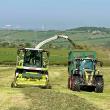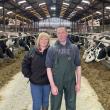Advanced Robot were the first company with a dedicated robotic division and were able to pull data out of the robots regularly to make improvements on farm.
Welcoming Winter
As we head through these next months, we start to think about preparations for Winter to maximise the health of your dairy herd...

- Forage
- Forage Analysis – have you had a sample taken? Understanding the nutrients within the forage will aid the balance of the whole diet – forage changes updating the analysis a few times through winter will ensure the diet being fed remains balanced.
- Forage Quantity – Do you know how much silage you have and of what cut? Creating a forage budget now, will identify if there is enough for winter, if not a plan can be developed now to enable a consistent diet throughout winter.
- Fieldwork – Repair
- If the weather will allow, checking for compacted soils and opening up to enable air infiltration will help plant survival over winter.
- Soil Sampling – understanding the nutrient levels may result in changes to the type and quantity of fertiliser required for next spring, as well as ensuring the pH levels are maintained to maximise the fields performance.
- Heifers
- Housing of heifers will soon be here if not done already. Is the shed ready?
- Ventilation – ensuring adequate ventilation will reduce the risk of ailments like pneumonia – A smoke bomb exercise may be a simple way of assessing if there is adequate ventilation.
- Micro climates – prepare what you will do when the temperature drops, micro climates are especially useful for grouped younger calves, making sure there is a place for them to get out of any draughts. Calf jackets are also worth considering, if its too cold the calf will be using her energy to keep warm rather than using it to hit growth targets.
- Lighting
It is well documented that if the milking herd have adequate light, both intensity and timed performance can be improved by more than 5%. In anticipation of the winter evenings
- Lactating cows appear to perform to an optimum when they receive 16 hours at 200 lux and 8 hours at 50 lux
- A light meter will give a guide as to the light levels across the whole shed – ensure there are no shadows or dark corners
- Having the lights on a timer simplifies when they are on and off
- The dry cow pen is the reverse with 16 hours at lower light intensity and 8 hours at 200 lux
If you require any further information on any of these hints and tips, please don't hesitate to get in touch with a memeber of the team.
〈 BACK




